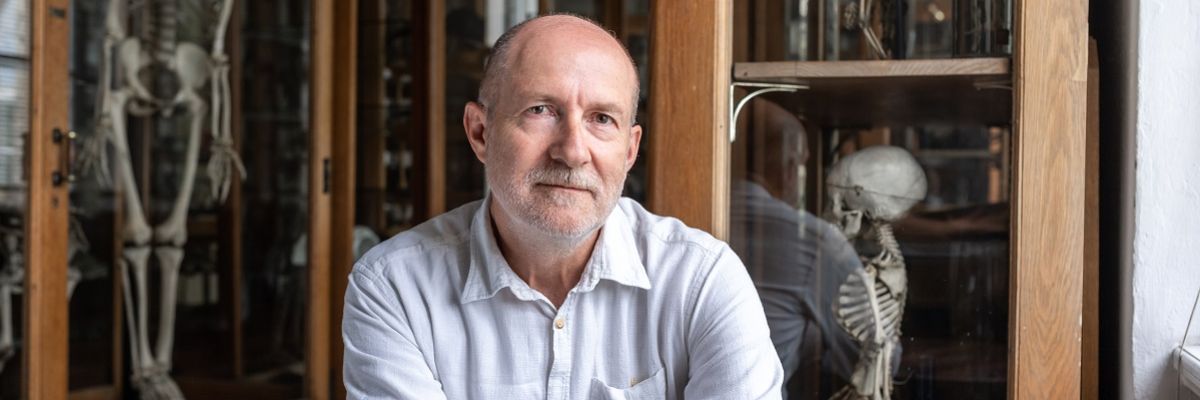
Anthropologist Viktor Černý in search of modern human origins
05. 02. 2024
More than 300,000 years ago, the anatomically modern human emerged in Africa. From there, Homo sapiens migrated to Asia and Europe. For more than 25 years, anthropologist Viktor Černý has been exploring the genetic traces of the modern human. The following story appeared in Czech in A / Magazine, published quarterly by the Czech Academy of Sciences.
Africa. The vast, biologically diverse continent is – according to prevailing scientific knowledge – the cradle of humankind. And yet, we still know so relatively little about it. For a long time, what lay beyond the arid, impenetrable Sahara was a great unknown. For instance, in the first century CE, the Roman geographer Pomponius Mela depicted the local inhabitants as follows: “There are, then, on the other side of what we have just called wastelands, mute peoples for whom nodding their head is a substitute for speaking. Some make no sound with their tongue. Others have no tongues. Still others have lips that even stick together except for a hollow reed beneath their noses through which to drink by means of a straw…”
A more significant source of information about the regions south of the Sahara did not appear until Arab geographers and traders began exploring them from the seventh century onwards, successfully spreading their religion and culture there. It wasn’t until much later that Europeans undertook the journey across the desert on a larger scale, with major expeditions by German, French, and British explorers taking place mainly in the nineteenth and early twentieth centuries. The territory between the Sahara and the tropical rainforests revealed something that the explorers had not seen anywhere else before.
They were intrigued not only by the diversity of the landscape and nature, but also by the great diversity of the population. The geographical region, which stretches from the Atlantic Ocean in the west to the Red Sea in the east, is called Sudan (from the Arabic bilād as-sūdān (بلاد السودان) meaning ‘the land of the Black [Africans]’) and includes the Sahel region bordering the Sahara.
At the heart of the Sudan-Sahel region of Africa lies Lake Chad, its size and shape dynamically fluctuating due to climate change. While the deserts in the north have an average of one inhabitant per 10 square kilometres, the Mandara Mountains is densely populated, with more than 3,000 inhabitants in the equivalent area. Here we can find three of Africa’s four biggest language families – Afroasiatic, Niger–Congo, and Nilo-Saharan languages, as well as Muslims and traditional indigenous cults, nomadic pastoralists, and settled farmers.

Sahel is the name of the region in North Africa at the southern border of the Sahara, which it separates from the African tropical rainforests.
Map of Sahel: https://en.mapy.cz/zakladni?x=17.5698557&source=area&id=276404&y=0.6498557&z=4&ds=1
Africa won’t let you go
Evolutionary anthropologist Viktor Černý from the Institute of Archaeology of the CAS in Prague first visited the African continent during his university studies, assisting with Egyptological research at the time. “But Egypt, that’s just the gateway to Africa. Later, when I visited Cameroon, it became clear to me that the Nile would no longer be enough to quench my thirst,” the anthropologist recalls with a smile, years later. What became a life-changing experience was his research stay of several weeks with the Fali ethnic group in the northern Cameroonian village of Ngoumi, which he visited at the invitation of his French colleague, ethnologist Jean-Gabriel Gauthier.
“I noticed that the herders and farmers were living separately in the area, and it led me to ask myself: from where and how did these people come to live here, and how did the economy of the Sahel region actually take shape? Since then, I have visited the Sudan-Sahel region many times. Once Africa ensnares you, it doesn’t let you go,” says Viktor Černý from the Institute of Archaeology of the CAS, Prague.
The vast area, spanning from Senegal in the west to the Ethiopian Highlands in the east, has so far been partially explored with an ethnological focus, less so an archaeological one, but in regard to evolutionary genetics, practically not at all. “I said to myself that I wanted to focus on this and that I had a free range of activity here. My colleagues from Western Europe and the USA also showed interest in the topic and together, we managed to reach interesting findings,” the researcher recalls. The result of several years of research was a series of scientific articles, as well as a popular educational exhibition at the National Museum in Prague, Between the Sahara and the Tropical Rainforests, and a book, The People of Lake Chad.
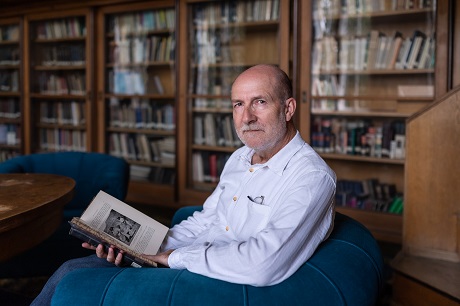
Originally, Viktor Černý wanted to become a veterinarian and was also interested in tropical medicine, such as the treatment of malaria. He also considered palaeontology, because he was fascinated by fossils as records of different life forms from a long gone era. (CC)
The traditional, nomadic Fula people
Among other things, the focus of Viktor Černý’s research team in Africa was on the genetic diversity of the Fula, or Fulani, ethnic group. The Fula people can be found in 17 African countries from eastern Senegal to western Chad, numbering around 30 million. Most of them lead a sedentary lifestyle, but some are nomadic, like their ancestors, whose prehistoric paintings and engravings have been preserved in the rock massifs located in central Sahara.
The genetic traits of the nomadic Fulani people have not yet been the focus of scientific attention, as their frequent migrations have made them rather difficult to reach. However, thanks to the cooperation of local linguists and assistants, Viktor Černý’s team managed to establish contacts with more than a dozen groups of the Fulani nomads in Cameroon, Chad, Niger, Mali, Mauritania, Senegal, and Burkina Faso and collect a series of biological samples from them.
In these samples, the researchers discovered not only sub-Saharan but also Eurasian haplogroups (specific combinations of mutations in a given segment of DNA) – the same ones found in populations in North Africa. This means that the inhabitants of North Africa and the nomadic Fulani people may have a partially shared genealogy. They may have encountered each other, for instance, in the aforementioned Central Saharan regions. Around 10,000 to 6,000 years ago, the climate in the Sahara was very favourable, as evidenced by the depiction of giraffes, hippos, and crocodiles on local prehistoric rock carvings.
Researchers have also found previously undescribed mutations in biological samples of the nomadic Fula and identified entirely new haplogroups. The emergence of a separate haplogroup in human DNA requires at least several millennia – it is evident, then, that the Fula people are a very ancient population.
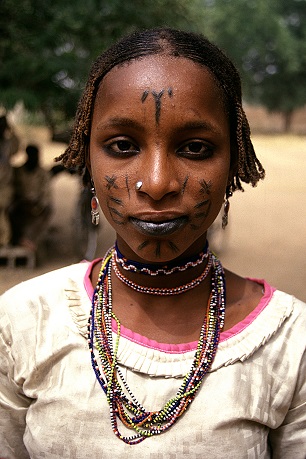
A girl from a nomadic Fulani group, Cameroon.
A community of milk drinkers
Another interesting trait the nomadic Fulani people have is a genetic mutation that allows them to digest fresh milk, unlike the long-settled farmers who lack this phenotype. This ability, which only about one third of humans worldwide possess, is called lactase persistence. It has evolved in the European population, especially among northern Europeans – up to 96% of the population in Scandinavia or the UK has it (in the Czech Republic, it’s about 80%), while in Southeast Asia or amongst the indigenous populations of Australia and the Americas, for instance, the mutation is almost non-existent.
A detailed examination of the individual mutations associated with lactase persistence has shown that they may have arisen independently of each other in different regions in Europe, Arabia, and Africa. However, the “European” mutation has also been found in the nomadic Fulani. “According to our results so far, it seems that some two thousand years ago, i.e., relatively recently, Eurasian and African populations may have come into contact. One had the phenotype, the other did not, and they passed it on to each other,” Černý explains.
Pastoralists who acquired the mutation fared better in the milk-consuming communities than those who did not. Because of the adaptation, they had more children, and the population with the lactase persistence phenotype thrived and expanded.
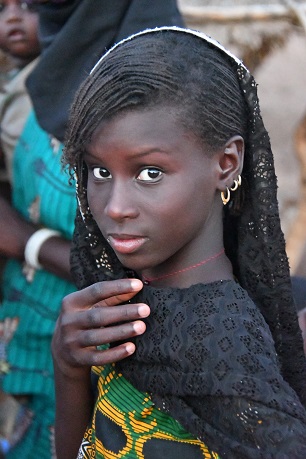
A Fulani girl, Mauritania.
A connected world
The similarities and interconnectedness in the genetic material of different global populations is something that fascinates Viktor Černý. Over the past twenty-five years, he has acquired a large stock of biological samples not only from Africa, which has been a calling for him from the very beginning, but also from southern Arabia, which he discovered for himself a bit later, but which captivated him just the same. Černý made his first research trip to Yemen in 2005 when he did not know much about the realities of this unique country. That is why he began to search through Czech popular science literature that could help him discover more about Yemen. Apart from a few travel books, he found nothing, and so he decided to write such a book himself. The result is the monograph Po stopách Ádů – Jižní Arábie v čase a prostoru, published eleven years after his first trip to this remarkable region.
On a world map, we can see that the south of the Arabian Peninsula may be the link between Africa and Asia – it is separated from Africa by a narrow strip of the Red Sea, and from Asia by the Persian Gulf and the desert. In the distant past, Arabia bridged the regions in which distinct civilizations later developed – Nubia, Ethiopia, and Egypt in Africa, as well as Palestine, Mesopotamia, and Persia in the Near East, and India in South Asia. At the same time, it should be noted that this was not a “direct route”. Migrations occurred in response to a changing climate. For instance, the shrinking of the Red Sea may have facilitated the passage of people for a period of time and hastened the deterioration of living conditions in more arid Africa.
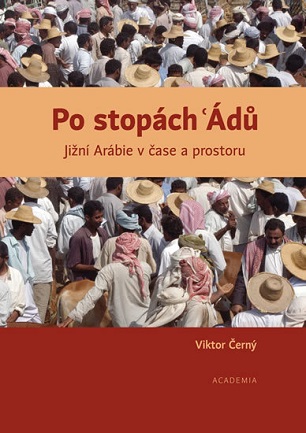
Prior to his research trip to Yemen in 2005, Viktor Černý couldn’t find any Czech comprehensive popular science books about the country – so he decided to write one himself.
Out of Africa into the world
The first migrations of populations of the Homo genus from the cradle of Africa occurred more than 1.5 million years ago. This was the ancestor of the modern human, i.e., Homo erectus. It spread throughout Eurasia and continued to diversify and evolve there over the next hundreds of thousands of years. Later, around 500,000 years ago, another species of man, also originating in sub-Saharan Africa, appeared in Eurasia – Homo heidelbergensis. On the European continent, this species evolved into a distinctive variant – Neanderthals (Homo neanderthalensis), adapted to living in colder environments, and in Africa into the anatomically modern human (Homo sapiens).
Homo sapiens expanded from East Africa to Eurasia later, probably arriving in present-day Arabia sometime in the late Pleistocene (approximately 125,000 years ago). Homo neanderthalensis spread from Europe in the opposite direction towards Asia and the Near East, but gradually began to falter in numbers. At some point 50,000 years ago, Neanderthals began to die out, apparently because they could not adapt to climate change or because they could not compete with the African Homo sapiens, who had better hunting, communication, and probably reasoning skills as well. Most likely, the two species encountered each other and partially intermingled.
“The modern human currently carries about two to three percent of the Neanderthal gene. We have taken from them variants of genes that were more advantageous for living in the Eurasian environment, just as the ancestors of today’s Fulani acquired the lactase persistence phenotype from the North African population of European origin,” Černý explains. For instance – “Neanderthal” genes code for certain skin proteins that helped us adapt to living in regions with less sunlight.
The end of the Pleistocene Era appears to be a period when several archaic populations encountered each other and contributed to the genetic diversity of our ancestors, including the Neanderthals in East and Southeast Asia, the Denisovans and perhaps other archaic Hominini whose fossils have either not survived or have not been discovered – yet. However, genetics provides quite clear evidence of such encounters.
|
PRAEMIUM ACADEMIAE Viktor Černý was awarded the 2022 Academic Award (Praemium Academiae). This prestigious award is bestowed every year by the Czech Academy of Sciences to outstanding scientific figures whose research is deemed very promising. Generous funding of up to CZK 30 million can be used by the laureates over a six-year period, allowing for the longer-term development of their projects. “It was often that our research would be interrupted due to our having to wait until we received another grant to continue it. For the first time in twenty-five years of conducting research in non-European areas, I can plan everything with a longer perspective, which is reassuring,” the laureate says. Černý plans to direct two-thirds of the resources to fund his team, the rest will go into genetic data analysis and the dating of archaeological material. The award enabled an international expedition to Oman, led by researchers from the Institute of Archaeology of the CAS in Prague, last spring. |
A crossroads of nations
Different populations may have encountered each other in places where migration routes cross – for instance, in the regions of southern Arabia. To investigate the genetic links between Arabia and its neighbouring regions, Černý’s team managed to collect a large set of 14,280 mitochondrial DNA sequences of contemporary inhabitants of the Near East and parts of the Balkans, the Middle East, India, and East and North Africa in 2008 and 2009. Each of the regions was represented by more than two thousand genome sequences (segments of DNA).
In the inhabitants of Arabia, the researchers discovered multiple haplotypes shared with populations living in the vicinity. This indicates that in the past, there must have been frequent biological contact and migrations within the region. At the same time, Arab populations have been shown to share significant kinship with the Middle East and North Africa. In contrast, East Africa, from where anatomically modern humans originally spread, today seems to be genetically more distant from Arabia.
The paths of prehistoric peoples intersected progressively further into South Asia. It is this region that Černý now wants to focus on in more depth to offer new interdisciplinary insights into the variability of local populations. However, there is a certain complication at play here compared to other regions – for example, India or Nepal do not allow the export of genetic material. “I’m still in the process of establishing contacts there. The plan is to have the samples analysed there, but I don’t yet have a reliable network of colleagues to work on this with. I am starting from scratch in this vast and culturally diverse environment, just as I did in Africa and Arabia years ago,” the evolutionary anthropologist adds.
His research has a distinctly international character, with researchers from various countries coming together to contribute with their insights to the researched subject as a whole. After all, the main topic of anthropological research is biological variability, and this type of research cannot be done well from a unilateral national perspective. “We evolutionary anthropologists perceive everything in a long-term and in a kind of global perspective,” Černý concludes. From their very beginnings, humans have been incredibly diverse and interconnected as a species, not only in Africa, but all over the world.
|
Prof. Mgr. Viktor Černý, Ph.D. He studied anthropology at the Faculty of Science of Charles University and completed his postgraduate studies at the University of Bordeaux in 1999. He works at the Department of the Natural Sciences and Archaeometry at the Institute of Archaeology of the CAS in Prague and teaches human evolutionary genetics at the Faculty of Science (Charles University). As an evolutionary anthropologist, he is interested in contemporary human genetic diversity in the context of prehistoric events and processes (climate change, cultural innovation, etc). He has authored numerous scientific articles and two popular science books, The People of Lake Chad (2006) and Po stopách Ádů – Jižní Arábie v čase a prostoru (2016, both Academia Publishing House). |
The story was published (in Czech) in A / Magazine as “Pravlast lidstva za řekou Nil”.
2/2023 (version for browsing)
2/2023 (version for download)
Prepared by: Leona Matušková, External Relations Division, CAO of the CAS
Translated by: Tereza Novická, External Relations Division, CAO of the CAS
Photo: Jana Plavec, External Relations Division, CAO of the CAS; Mapy.cz; Viktor Černý; Academia Publishing House
 The text and photos marked (CC) are released for use under the Creative Commons license.
The text and photos marked (CC) are released for use under the Creative Commons license.
Read also
- The beauty of Antarctic algae: What can diatoms tell us about climate change?
- Moss as a predator? Photogenic Science reveals the beauty and humor in research
- How does the Academy Council plan to strengthen the Academy’s role? Part 2
- How does the Academy Council plan to strengthen the Academy’s role? Part 1
- Ombudsperson Dana Plavcová: We all play a role in creating a safe workplace
- ERC Consolidator Grant heads to the CAS for “wildlife on the move” project
- A little-known chapter of history: Czechoslovaks who fought in the Wehrmacht
- Twenty years of EURAXESS: Supporting researchers in motion
- Researching scent: Cleopatra’s legacy, Egyptian rituals, and ancient heritage
- The secret of termites: Long-lived social insects that live in advanced colonies
The Czech Academy of Sciences (the CAS)
The mission of the CAS
The primary mission of the CAS is to conduct research in a broad spectrum of natural, technical and social sciences as well as humanities. This research aims to advance progress of scientific knowledge at the international level, considering, however, the specific needs of the Czech society and the national culture.
President of the CAS
Prof. Eva Zažímalová has started her second term of office in May 2021. She is a respected scientist, and a Professor of Plant Anatomy and Physiology.
She is also a part of GCSA of the EU.
